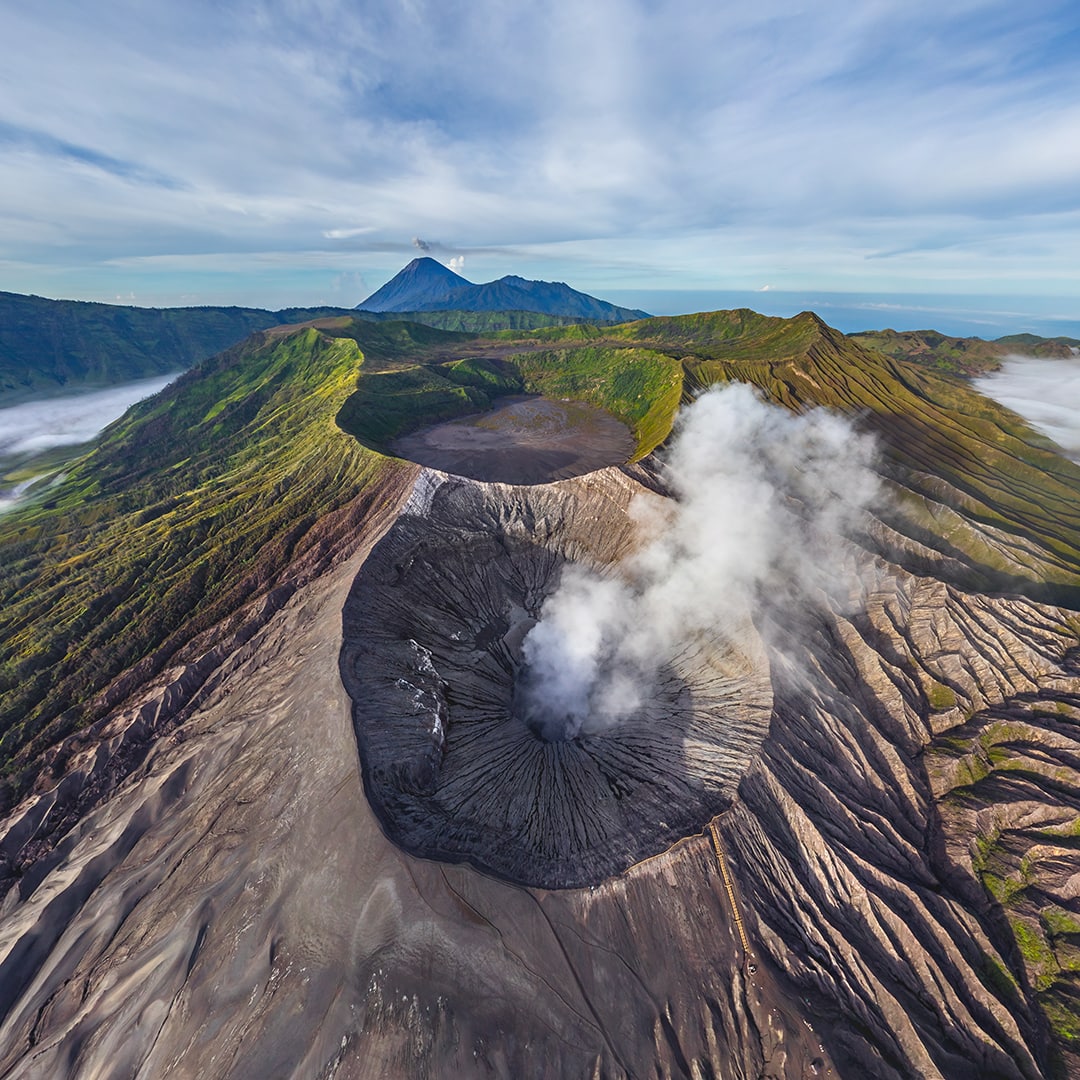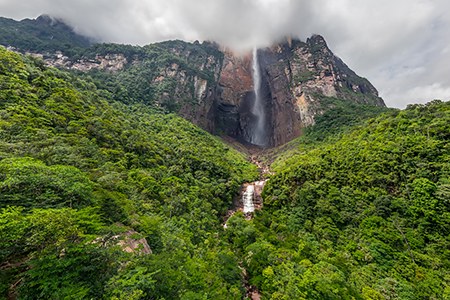New 7 Wonders of the World
The Seven Wonders of the World is a list of the most famous monuments of human genius created before our time. Since then, humanity has created a number of other amazing masterpieces of architecture. There have been multiple attempts to review and edit the original list, and even alternative lists have been proposed.
The most successful project, "The New Seven Wonders of the World" took off in 2000 using modern technology. During the next 7 years (up till 2007), New Open World Corporation, a non-profit organization has collected public votes for the world's best landmarks via SMS, telephone, and the Internet.
Having a goal to create panoramic photographs of the most beautiful places of our planet, we couldn't pass up the New Seven Wonders of the World. Moreover, by that time we had already photographed the Great Pyramid of Giza (also known as the Pyramid of Cheops), the only one of Seven Wonders of the Ancient World still standing. Pyramid of Cheops was included to the list of New Wonders of the World at number 8 as an honorary site. Let us show you photo panoramas of the most remarkable places of the modern world.
Photographer's Notes on Shooting the New Seven Wonders of the World
Machu Picchu, Peru

Machu Picchu was the first of the "Wonders" that we visited to make our aerial photo panoramas. Lacking practical experience, we believed that we would receive a warm welcome wherever we'd go. However, security guards did not let us enter the ancient city hidden within the jungle with our photo equipment. Being very persistent, we took our radio-controlled helicopter apart, passed the security checkpoint, and assembled it on the territory of Machu Picchu. After shooting several panoramic images during our first flight, we got arrested. During three long hours police officers filed their papers and studied our equipment. We managed to save the footage, but all other attempts to fly our RC helicopter were strictly prohibited. During the following two days we have been closely watched by the Machu Picchu Park security: every time we passed the security point with our tripods, they thoroughly searched us, trying to find helicopter parts even in our pockets. Finally, we booked a room in a hotel right by the park entrance and took off from the hotel backyard, getting a perfect view of the "World Wonder". The guards were very unhappy, but couldn't stop us — technically we flew over the hotel territory. This was the beginning of the series.
The Taj Mahal, India

Being aware of how difficult it is to photograph the Taj Mahal, I went to India beforehand to meet with the Chief Architect of the city of Agra. The Chief Architect listened carefully to the guest from distant Russia and said, "I will allow you to shoot from a tripod, but you will never get a photo permit for an aerial photograph. The last person who photographed the Taj Mahal from the air was the famous Frenchman Bertrand. 15 years ago he took several long distance pictures from a big helicopter."
This is why we decided to prepare for the Taj Mahal photo expedition very carefully. It took us several months to get a permit and a whole lot of paperwork from the Indian Embassy in Moscow. However, local authorities (represented by this very Chief Architect) believed that it would be inappropriate to break a 15-year-old tradition of forbidding aerial photography. We didn't want to leave empty-handed! Taking a risk, early in the morning we flew our RC helicopter near the Taj Mahal walls and immediately got surrounded by armed security guards. They were very convincing when telling us to land the helicopter right away. We barely got ourselves out of trouble by showing the permits that we had brought from Moscow. Discouraged, we called the embassy and told them about this extremely cold reception. They promised to sort everything out within a week. Unfortunately, we couldn't wait for a week (which could then have turned into months or even years of waiting), and so we went to pack our suitcases.
On the following day we received a phone call from the Chief Architect's office asking, "Why are you not shooting today?" Quite shocked, we went to the office and were handed an official 3-day photo permit! We have no idea what buttons have been pushed. Later we learned that it might have been a personal favor of the Indian Ambassador in Russia... However, even with the said-permit in hand, the path from the gates to the palace took us nearly an hour (which is usually just a 10-minute walking distance). Every single power-bearing official who saw our equipment had to check our paperwork. Then, he would shake his head in disbelief, make a phone call and... walk us to the next official representative of the park. Nevertheless, we managed to photograph the Necropolis and the park from all angles, shoot a video, and take numerous photographs. The large photo panorama of the Taj Mahal now hangs on the wall in the Indian Embassy.
The Colosseum, Rome, Italy

By the time we reached Rome, we had gained a lot of experience. However, we prepared no photo permits for the Colosseum. Conveniently enough, our trip was scheduled in May, when the sun rises rather early, so we hoped that nobody would ask for a photo permit at 5a.m. in the morning. We flew our RC helicopter near the Colosseum at sunrise, waiting for a possible reaction. There was none: no armed security guards came to arrest us, perhaps, because the area was completely empty. The Colosseum was beautiful in the morning sun, but we would have to return during the day in order to shoot the structures lit from the inside. Having chosen the location beforehand, we came back in the afternoon and flew some more near the Colosseum. Again, no one said a word, and so we returned at night and photographed the illuminated arches of the Colosseum absolutely carefree.
Suddenly, we realized that I left our retractable pole (required for shooting panoramas inside the main structure of the Ancient Rome) at home. A year later I had to buy a ticket and return to Rome one more time to finish the job. I never left the pole at home again! By the time the guards noticed my strange 6-meter long stick and me, I had already covered most of the key locations. After visiting Rome, I got a strong impression that the entire city could have been named a "Wonder of the World" — it is called the Eternal City for a reason.
The statue of Christ the Redeemer, Rio de Janeiro, Brazil

Our first attempt to reach the statue of Christ the Redeemer on Corcovado Mountain disguised as tourists was stopped by a watchful guard at the elevator leading to the monument. Despite the fact that we didn't speak Portuguese, we figured out what company manages the monument and went directly to the Tijuca National Park's administration. Our conversation didn't go very well until we remembered that there was a gift-wrapped 2-meter-long print of the morning Rio de Janeiro panorama in our trunk. The founder of the Airpano website had shot the panorama right from the foot of the statue. After seeing this beautiful picture, the Park officials warmed up and promised to look into our case. In a couple of days they called us, saying that the park had no objections, but we'd have to get the Cardinal's approval. Apparently, the statue was under jurisdiction of the Church, not the park. We entered into a lengthy correspondence with the Church and (oh, miracle!) we got their blessing.
However, approaching the entrance gate early in the morning, we thought that all our efforts were fruitless — thick fog covered the entire area. Sad and discouraged, we went up to the observation point in front of the statue. The sun was rising, but we couldn't see even the outstretched hands of the 30-meter-tall statue. Suddenly, the clouds moved, the fog lifted, and a red ray of the rising sun hit the statue. In a few minutes everything was covered in fog again, but we didn't miss our chance and flew our helicopter. Some time later, the panorama of the statue of Christ the Redeemer in the morning fog won First Prize in the prestigious international photo contest. To tell you the truth, our flying machine got wet after this first flight and simply refused to work till we dried it with a hair dryer in our hotel room. But the main goal was accomplished! I returned to Rio de Janeiro again in a few weeks and added several aerial panoramas shot from a regular helicopter, but I have never seen such a beautiful light like we had during that foggy morning again.
Chichén Itzá, Mexico

This time we played it wisely and posted a request on our website, looking for help in our photo expedition to Mexico. We got in contact with Ricardo, a pilot and a specialist in aerial photography. He quickly took our official request to the right place (he knew exactly where to go!) and so our paperwork was successfully sorted out before the trip. Before going to Mexico, we stopped at Guatemala to practice shooting ruins of the giant Mayan complex called Tikal. Our path to Chichén Itzá went through Beliz where we spent 5 hours at the border checkpoint waiting for our visas in the +36˚C heat. Apparently they were checking our names against the Interpol database because our passports with numerous visa stamps looked suspicious (later we were told that they took us for narco couriers)... We arrived at our next Wonder of the World late at night. To be honest, we love the softness of the morning and evening light because it is the best condition for taking beautiful pictures. Unfortunately, usually places of our interest are closed to public at this time. The Chichén Itzá Park administration, however, did not allow us to work during the day. Instead, they offered us access one hour before and after their regular hours of operation. Needless to say, we were very happy. We were slightly disappointed by Chichén Itzá: The one large pyramid and a few smaller structures scattered around the area were not suitable for an aerial photograph. We thought that Tikal in Guatemala and Teotihuacan in Mexico was much more interesting. Another observation: as soon as a place is added to the list of "Wonders of the World" the number of tourists rapidly increases as well as the number of restrictions. For example, they used to let people climb up to the top of the Temple of Kukulkan to admire the sunset. Now, we found it fenced off with a rope, and public access to staircases was prohibited.
The Great Wall of China

Photographing the Great Wall of China was difficult and easy at the same time. It was easy because we didn't need any special permits. It was difficult because the wall is — how should I put it? — Very long. Another challenge was finding a good angle; parking lots and modern structures should not be in the picture. Wise emperors built the wall on top of high hills and mountains, and so it took a lot of effort to climb them. We selected five locations that were reasonably accessible from Beijing; some of them were completely restored parts of the Great Wall that were flooded by tourists; some of them were half-ruined mossy ancient structures made of stone, where we met only one or two travelers per kilometer. There was one area I remembered in particular where a part of the wall ran into the lake (a result of a new dam built nearby), disappearing underwater. However, after visiting all locations, our team unanimously proclaimed Jinshanling the most beautiful part of the Great Wall. Located 200 kilometers from the capital, it offered a variety of landscapes that turned into amazing pictures.
We had several free hours at the end of our hard 2-week photo trip to China, and so we decided to return to Jinshanling to enjoy this peaceful place once again. We wanted to walk the stone steps surrounded by overgrown shrubs with colorful autumn foliage. We watched the sunset at the highest observation point while drinking coffee in a small coffee shop. The owner of the coffee shop was a photographer who sold his photo albums with wonderful images of the Great Wall right on the spot.
Petra, Jordan
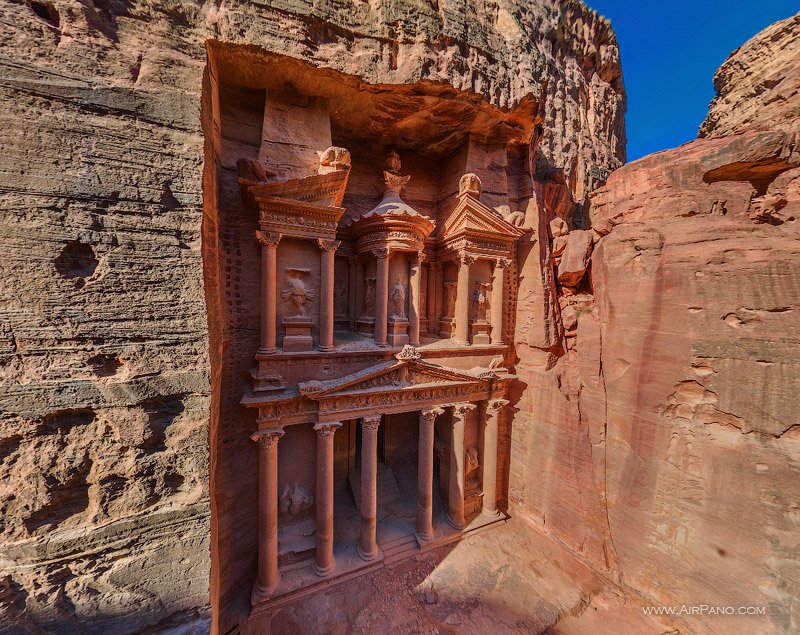
If I were to sort all Wonders of the World by their greatness, I would definitely give first place to the ancient city of Petra. I have already been to Petra in the early 2000s. Charmed by the giant temples and tombs carved in the mountains, I wanted to come back here once again. We have tried to obtain photo permits for two years, sending one letter after another, but, unfortunately, we haven't heard back. We even wrote to the King of Jordan — no luck. Finally we were introduced to representatives of "RosSotrudnichestvo", the Russian Federal Agency overseeing cultural relations with foreign countries. This time it worked, and so we arrived at the capital city of Aman with proper documents.
They gave us a curator (or a personal guide) in Petra. He was a happy man of Jordan origin, who knew everyone in the area. Thanks to him, we were allowed to drive up to the tombs with our equipment. He also helped us carry our heavy photo bags, arranged candlelight one hour before the usual night performance, and even negotiated five minutes of shooting inside the Treasury, which is now closed for public (Back in 2001 this area was open for tourists, but Petra has become the New Wonder of the World since then, and so the rules have changed).
The Rock City, or Petra, is large. Getting from one place to another was very tiring, and so we had to use donkeys. Our helicopter pilot will definitely remember our 800-step-long climb to the Monastery, the largest structure in Petra, on the back of a rather stubborn «means of transportation». We watched our last sunset in Petra in front of the Monastery with a traditional cup of coffee. The drink was strong, fragrant, and with a touch of acidity. The bitter taste of coffee made us realize that we have just finished photographing the last place of the New Seven Wonders of the World...
But wait, the most wonderful «Wonder of the World» happened at the very end! When we were saying our good-bye, the guide told us «You shouldn't have written to the King. You are good guys. Next time, come directly to me and I will arrange all photo permits for you myself».
The Giza Necropolis, Egypt

Although the Pyramids of Giza are also on the new list of Wonders of the World, they stand apart from other finalists. The Giza Necropolis is not considered one of The New Wonders of the World, but it still bears the title of the «Honorable Candidate». Due to unknown reasons, the pyramids withdrew their application from the contest. However, it was impossible not to include them to the list of existing Wonders of the World. As a result, the Pyramids of Giza have their unique and most honorable place in the list.
It is impossible to fit the story of our photo expedition to Giza in one paragraph, so here is the link for those who wish to read the full story.
You can see our best panoramas of each of New 7 Wonders of the World here, in one virtual tour. If you want to see more of every of the wonders, you can do it here:
5. Christ the Redeemer Statue, Rio de Janeiro, Brazil
7. Chichen Itza, Yucatan, Mexico
8. Great Pyramids of Giza in Egypt
And now let me share few interesting facts about New 7 Wonders of the World.
The Colosseum, Rome, Italy

The meaning of the name in Latin is "huge, colossal". This is true. The Colosseum, the monument of the ancient Roman culture, was and still is the largest of all man-made amphitheatres: the length of its outer ellipse is 524 meters, its large axis is 188 meters, and its minor axis — 156 meters. It sets an unbeatable record. The Colosseum of the ancient Rome hosted multiple events arranged for public entertainment, such as gladiator fights, animal fights, and land and water battles. They also celebrated the one thousand year anniversary of Rome in the Colosseum arena.
The Great Wall of China

The Great Wall of China is one of the largest structures in the world. Its construction began in 3rd century BC to protect the northwest borders of the empire from invasions from nomadic peoples. According to the master plan, the wall had to run for thousands of kilometers along the sierra, bending around cliffs and conquering heights and deep gorges of the mountains. This, along with its remarkable scale (over 8 thousand kilometers!), is what makes the Great Wall of China unique.. It perfectly blends into the surrounding picture, becoming a part of the landscape.
Machu Picchu, Peru

Machu Picchu is the "lost in the clouds" residence of the Incas built on a 2450-meter elevation, presumably around 1440 AD, as a sacred highland refuge. The city was occupied up till 1532 AD. When Spaniards invaded the Inca Empire, all residents of Machu Picchu mysteriously disappeared. Since that moment, the city has been in ruins for more than 400 years.
Today Machu Picchu is popular among both tourists and archeologists alike. The architectural masterpiece is still full of secrets: basic principals and exact time of construction, its purpose, and destiny of its people still remain unclear. The mysterious highland refuge of the disappeared civilization took its rightful place in both the "UNESCO Heritage Sites" and "The New Seven Wonders of the World" lists.
Petra, Jordan

Around 4th century BC, on the territory of modern Jordan, the Arab tribe of Nabataeans built a strategically important city in the depths of the mountain gorge. It became a hub for most commercial roads. Later, Greeks gave the city the new name "Petra", which means "a rock".
Petra is a symphony of stone, music set in architectural forms and shapes. High in the mountains, (over 900 meters above the sea level) cultural, religious, and other structures are carved right in the colorful warm sandstone. There is no other place like Petra in the world.
The Taj Mahal, India

The white marble mausoleum practically became an official symbol of India. In the middle 13th century, 20 thousand workers for over 20 years built the monument in memory of a deceased wife of the Mughal Emperor Shah Jahan.
Four minarets frame the five-dome tomb, which rises 74-meters high above the surrounding park and water channels. The walls are made of semi-transparent polished marble decorated with gemstones. The marble is white in bright daylight, pink at dawn, and silver at night. This is a rare monument that one can see and feel at the same time. This is a love story wonderfully set in stone that touches everyone who comes to see it.
The statue of Christ the Redeemer, Rio de Janeiro, Brazil

There is a giant statue of Christ on top of the 700-meter-high Corcovado Mountain in Rio de Janeiro. Christ opens his arms over the city as if blessing the land beneath him. Along with the 8-meter-high pedestal, the monument rises up to 38 meters, its weight is 1,145 tons, and its arms stretch out to 30 meter wide.
Every year almost 2 million tourists and local people climb up to the top of the mountain to take a picture with the statue "for good luck". It goes without saying that such a landmark of Brazil and the entire world was included in the list of the most remarkable "wonders" created by mankind.
Chichén Itzá, Mexico

The pyramids of Chichén Itzá in Mexico are the political and cultural center of the ancient Mayan civilization. Since 7th century AD, the Mayan people have built not only the major architectural complex, but also a masterpiece of astronomy and mathematics. Ritual structures of Chichén Itzá correspond with celestial charts and seasonal changes, revealing amazing optical phenomena during the fall and spring equinox. Chichén Itzá is a monument of yet another disappeared civilization, which takes your breath away with its grandeur, deep connection with the outside world, and the level of skills and talent put into its creation.
The Giza Necropolis, Egypt

The legendary original list of the Wonders of the World included seven ancient masterpieces created by mankind: the Lighthouse of Alexandria (Egypt), the Colossus of Rhodes (Greece), the Mausoleum at Halicarnassus (Turkey), the Temple of Artemis at Ephesus (Turkey), the Statue of Zeus at Olympia (Greece), the Hanging Gardens of Babylon (Iraq), and the Great Pyramid of Giza (Egypt). Unfortunately, only the last one on the list is still present.
The Great Pyramid of Giza is the largest pyramid of the whole complex of similar structures located on the Giza Plateau near the city of Cairo. All of them have been built in the Ancient Kingdome during the rule of 4th — 6th dynasties (26th — 23th centuries BC). There are several smaller pyramids near the Great Pyramid of Giza named after Cheops (Khufu): the Pyramid of Menkaure, the Pyramid of Khafre (Chefren), and others. Facing east the Great Sphinx of Giza is located in the eastern part of the complex. It is the oldest monumental sculpture in the world.
The construction of the 138-meters-high Great Pyramid of Giza took twenty years and was finished by 2540 BC. Besides having inner burial chambers, the pyramid could also have served as an astronomical observatory.
Initially, the surface of the pyramid was covered with a hard white limestone, and a gold-plated stone crowned the top of the structure. Unfortunately, this look did not survive through modern times. However, even after being vandalized and emptied, the Great Pyramid of Giza (and the entire pyramid complex located on the Giza Plateau) still amazes us with its harmony and grandeur.
Photo and text by Dmitry Moiseenko, Stas Sedov and Sergey Semenov
19 March 2014
Read more
Photogallery Machu Picchu, Peru #5
Machu Picchu, Peru #5
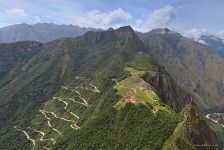 Machu Picchu, Peru #6
Machu Picchu, Peru #6
 Machu Picchu, Peru #4
Machu Picchu, Peru #4
 Petra, Jordan. Al Khazneh #1
Petra, Jordan. Al Khazneh #1
 Egypt, Great Sphinx of Giza
Egypt, Great Sphinx of Giza
 Roman Colosseum #1
Roman Colosseum #1
 Petra, Jordan. Al Khazneh #3
Petra, Jordan. Al Khazneh #3
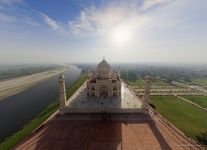 India, Taj Mahal #6
India, Taj Mahal #6
 Egypt. Great Pyramids #5
Egypt. Great Pyramids #5
 Mexico, Chichen Itza, Temple of Kukulcan in the last rays of the sun. Panorama
Mexico, Chichen Itza, Temple of Kukulcan in the last rays of the sun. Panorama
 Great Wall of China #9
Great Wall of China #9
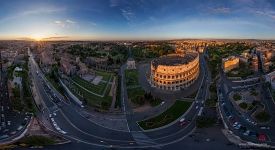 Roman Colosseum #10
Roman Colosseum #10



